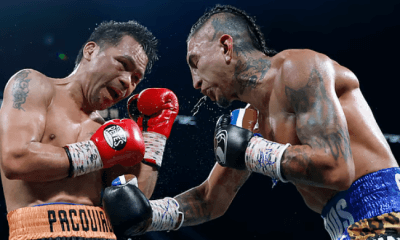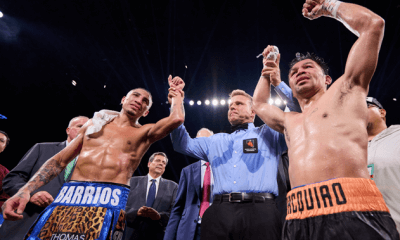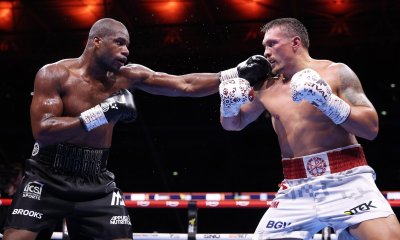Articles of 2006
Buddy Turman: Still Fighting, Still Winning
He didn't achieve his goal of becoming heavyweight champion of the world, but today 73-year-old Buddy Turman is putting up a fight even more impressive than the ones he waged against Archie Moore, Roy Harris and other ranked contenders of the 1950s and '60s.
It's his own personal Battle of the Long Count, and Turman's old friend Jack Dempsey himself—no fan of long counts—would be cheering this one.
In 1999, doctors diagnosed Turman with Stage Four Hepatitis C with significant cirrhosis of the liver, and told him that if he were lucky he would live for one more year.
“I've got news for you,” answered the former heavyweight champion of the Lone Star State. “You've never treated an old goat like me, and I'll go down fighting.”
He has his good days and bad days, says Turman seven years later, but on the whole “I've actually improved since then. That’s one thing about old fighters. A fight’s a fight, and it doesn’t make any difference whether it’s sickness or just another guy. You’d better keep on punching and do what Dempsey used to advise me: ‘Don’t lead with your chin and keep your butt off the canvas.’”
On the phone from Longview, Texas, where he lives with and is cared for by his sister Gayle, Turman sounds exactly like actor Rip Torn (“Defending Your Life,” “Men In Black I & II”), a fellow Texan, in discussing the life and boxing career that took him all over the world, and the interesting people he’s met along the way.
They are also the subject of a book written and published this year by Turman’s younger brother, Joe Garner Turman, called “Buddy: The Life of Texas Boxing Legend Buddy Turman.”
Born on April 12, 1933, in Noonday, Texas, Buddy Turman—who’s gone by the nickname since he was old enough to walk, and was stunned to learn upon entering grade school that his real first name was actually “Reagan”—started working on the family farm when he was four, and after he met the great Dempsey years later and the latter advised him to start chopping wood to build up his arms and shoulders, Turman told him he’d been doing it since he was six. The Turmans listened to Joe Louis fights on the radio in the 1930s, and cheered when Louis—with whom Turman would also later become friends—nuked Max Schmeling in less than a round in their famous 1938 title fight.
At 17, Turman knew he wanted to be a fighter, but in east Texas then there weren’t a lot of opportunities for that. So he joined the U.S. Navy and learned the basics while serving a 16-month hitch. After he returned home, Turman worked in the oil fields and started fighting in the amateurs. He won 20, lost five, and had one draw. Fourteen of Turman’s wins were by KO, thanks to the left hook that was the main weapon in his ring arsenal. “If I didn’t knock ‘em out, I usually didn’t win,” he says. “Clever fighters always gave me trouble, because you don’t hit them too good.” In 1954, he scored the quickest knockout in National AAU Tournament history before bowing out in the semi-finals.
On September 27 of that year, Turman beat Buddy Babcock in four rounds for his first professional win. His manager was Bobby Manziel, a wealthy oilman who wasn’t interested in developing and nurturing his fighter’s skills via the traditional long-and-winding route of preliminary bouts and careful matchmaking. That’s why just one fight and only three months after he beat Babcock, Turman found himself in a Birmingham, Alabama ring with 19-3 Oscar Pharo, fighting 12 rounds for the Southern heavyweight title.
As if that wasn’t unnerving enough for the 20-year-old Turman, Manziel publicly announced beforehand that after Buddy beat Pharo he would try to arrange a match between him and world champion Rocky Marciano.
Pharo’s decision victory ended that pipedream, but a month later, on February 24, 1955, Turman made national headlines when he won a 10-round decision over J.D. “Sporty” Harvey in the first interracial boxing match allowed in Texas. Harvey had gone to court to overturn the ban against fights between blacks and whites. Turman announced his willingness to fight him to help matters along, but it wasn’t just his belief that Jim Crow had no place in boxing that prompted him. “I was a fighter, and I wanted to fight,” he says. “I’d feel like a cheat if I didn’t fight everybody. I wanted to be champion. It was just the right thing.”
(In his book, Joe Garner Turman relates that a few years ago Buddy was playing “Texas Trivial Pursuit” with some relatives and their friends, and cleaned up on the question, “Who were the boxers who fought the first mixed boxing match in Texas?”)
Seven more wins followed quickly (including another one against Harvey), and on November 28 of that year Turman—called “The Golden Boy from Noonday”—met undefeated Roy Harris for the state title. Harris won a 12-round split-decision, and went on to fight Floyd Patterson for the world championship three years later. “Roy was a clever guy, hard to hit,” says Turman. “He couldn’t take a big ol’ punch, but Roy was worthy.”
Over the next three years Turman proved his own worthiness, winning 17 (including a first-round KO over Oscar Pharo) and losing only by decision to veterans Art Swiden (“Probably the cleverest and most knowledgeable fighter I ever fought. You couldn’t hit the son-of-a-gun”) and Donnie Fleeman. In the meantime, his friend Dempsey, whom Turman met through Manziel, was not only touting Buddy as a future heavyweight champion but also, when Hollywood was planning a film biography of the Manassa Mauler in 1956, as the guy to play him. But thanks to legal disruptions caused by Dempsey’s ex-manager, Jack Kearns, plans for the movie were shelved.
Against Big Bob Albright, a huge, strong heavyweight based in Los Angeles, Turman did what so many opponents did with him: “I made a mistake, and you can’t make a mistake with a puncher.” Albright knocked him down three times and the fight at Hollywood Legion Stadium was stopped in round two.
Two months later Albright came to Tyler, Texas for a rematch. Outweighed by 30 pounds, Turman knocked Albright out in the tenth round, and Big Bob spent the night in the hospital for observation.
In his only fight in Madison Square Garden, Turman won an impressive decision over Robert Cleroux of Montreal, the Canadian’s first defeat in 13 bouts. “It was just three weeks after Albright,” says Turman, “and I had my confidence up. And I’m glad I did, because when the bell rang old Cleroux came out punching. I punched with him and got the best of it. After the fight he had a cauliflower right ear, because every time I threw my right he’d duck and I’d hit his ear.”
Cleroux won his next 11 fights, including a decision over George Chuvalo for the Canadian title, and on October 26, 1960, he stopped Turman in a rematch in Montreal. Turman, who hadn’t fought since beating Sonny Moore the previous April, took the fight on a week’s notice. “I hadn’t been in the gym in some while. They wanted to catch me out of condition and get the win back (for Cleroux), and they did. He came out for blood, and I hadn’t prepared.”
Turman insists that the decision he lost a month later to light heavyweight champion Archie Moore in Dallas should’ve gone his way. A visitor to his dressing room after the fight thought so, too. “You beat that old man,” said young Cassius Clay to Buddy. The future Muhammad Ali was then a member of Moore’s entourage.
Archie himself was impressed enough with Turman to invite him to his training camp in San Diego. Buddy went and they became friends. In the spring of ‘61, Moore contacted Turman with a proposal for a rematch in Manila, Philippines. Turman agreed, and left for Manila six days before the scheduled fight. Then Archie sent word from the States that he needed a three-week postponement. Since the heaviest fighters in The Philippines were lightweights Turman got in no sparring in the meantime, and when the fight came off on March 25, 1961, he lost a unanimous decision.
“Archie and I were good friends, but of course he was a very clever guy and I always kind of felt that, being the ‘Old Mongoose,’ he sort of arranged that postponement to make sure I was rusty,” says Turman with a laugh.
Moore himself wasn’t laughing when he told reporters, “Buddy Turman should be rated among the top five heavyweights in the world. I’ve fought most of ‘em, and I know what I’m talking about.”
But a difficult divorce broke Turman’s concentration and momentum. After an eight-month layoff, he was knocked out by Pete Rademacher, the 1956 Olympic champion who fought Floyd Patterson for the world title in his first pro fight a year later.
Moorehad stopped Rademacher in six a month before Turman fought him, and “I figured—wrongly—that if Moore could knock him out in six, I could do it in one,” says Turman. “But he was a better fighter than I thought. After three rounds I was exhausted. He gave me a pretty good beating, and I deserved it. My corner stopped the fight (in round nine). I was so tired I couldn’t walk, hardly.”
After two more fights (including a draw with Scrapiron Johnson), Turman was out of the ring for a year. But not out of the media spotlight. It was 1963, and in late November Turman found himself talking to agents of the Federal Bureau of Investigation after the man arrested for the assassination of President John F. Kennedy in Dallas on November 22, Lee Harvey Oswald, was himself shot to death two days later on national TV by Dallas strip club owner Jack Ruby.
A boxing fan, Ruby had seen Turman fight a few years earlier and they became good friends. Turman sometimes moonlighted as a manager and “nice bouncer” at Ruby’s club, borrowed money from him, and even stayed at Ruby’s apartment a few times according to the FBI report included in the Warren Commission report on the JFK assassination. He worked in Ruby’s strip club for the first half of ‘63.
“I liked Jack. We got along just fine,” says Turman, adding that at one point he was one of just two people Ruby was said to trust in all of Dallas.
Over the years conspiracy theorists have ascribed all manner of dark political motives for the murder that sent Ruby to prison for the rest of his life, but Turman, who says he was “not surprised at all” by Ruby’s actions, insists that it all boils down to the simple fact that “Jack was emotional, and he really liked Kennedy. They all try to make Jack a villain, but Kennedy was his hero. They all want to conjure up stuff, but he was apolitical.”
After Ruby’s imprisonment Turman was never in contact with him again. “I wrote him letters and sent him money (in jail), but they wouldn’t accept it.”
Turman hit the comeback trail in ‘64. After wins in Utah and Nevada, it took him overseas for the last three years of his boxing career. While training in Los Angeles, he’d become friends with German heavyweight Wilhelm von Homberg, who in the mid-’60s moved back to his homeland and became embroiled in headline-grabbing controversies inside the ring and out. Turman joined him in Germany and they worked each other’s corners in fights all over the country.
Turman loved Germany, and not just because he won all seven of his fights there. “I felt right at home. Germans are down to earth. I liked the people, the food and the frauleins.”
In other European venues, though, the natives weren’t so hospitable. “I never won a fight in Italy,” says Turman, who dropped decisions there to homeboys Piero Tomasoni and Dante Cane, “but it was all questionable.” In Austria, Turman was disqualified after a body punch put Yvon Preberg on the deck. He had Jack Bodell floundering after four rounds of their fight in England, and at the end of the fourth the referee came to his corner and told Turman he was stopping the fight. “It’s about time,” said the American, only to find out that the referee was calling it a TKO for Bodell because Turman had a bloody nose.
“I didn’t care,” he says about all that. “I got paid, and my dream of winning the championship was gone by then.”
After 62 fights, Turman retired in 1967 with a 45-15-2 (32) record.
From what he sees of current boxers, Turman figures he would “do all right” if he were fighting today. “I’d probably be in the Top 10. I was Top 10 material when I was fighting.” He enjoys reminiscing about his friendships with Dempsey, Louis and Rocky Marciano (who, says Turman, “wouldn’t spend a nickel to see an earthquake”), and he and Roy Harris had a reunion recently that was a lot more pleasant than their first meeting. Turman spends time each day reading and trying to maintain his fluency in German.
He’s getting more attention lately thanks to the biography written by his brother Joe, who was a Baptist missionary for 30 years after getting saved at a Billy Graham revival at Madison Square Garden. The book (available at Joe Turman.com) touches lightly on Buddy’s disappointments in life and even his abuse of alcohol and drugs in the ‘60s, but is intended to present its subject in a positive, spiritual light.
The subject says it succeeds in that regard. “After I read it,” says Buddy, “I said, ‘Jesus, what a nice fella!’”
-

 Featured Articles3 weeks ago
Featured Articles3 weeks agoThe Hauser Report: Zayas-Garcia, Pacquiao, Usyk, and the NYSAC
-

 Featured Articles2 weeks ago
Featured Articles2 weeks agoOscar Duarte and Regis Prograis Prevail on an Action-Packed Fight Card in Chicago
-

 Featured Articles1 week ago
Featured Articles1 week agoThe Hauser Report: Cinematic and Literary Notes
-

 Book Review4 days ago
Book Review4 days agoMark Kriegel’s New Book About Mike Tyson is a Must-Read
-

 Featured Articles4 weeks ago
Featured Articles4 weeks agoManny Pacquiao and Mario Barrios Fight to a Draw; Fundora stops Tim Tszyu
-

 Featured Articles4 weeks ago
Featured Articles4 weeks agoArne’s Almanac: Pacquiao-Barrios Redux
-

 Featured Articles3 weeks ago
Featured Articles3 weeks agoRemembering Dwight Muhammad Qawi (1953-2025) and his Triumphant Return to Prison
-

 Featured Articles4 weeks ago
Featured Articles4 weeks agoOleksandr Usyk Continues to Amaze; KOs Daniel Dubois in 5 One-Sided Rounds












